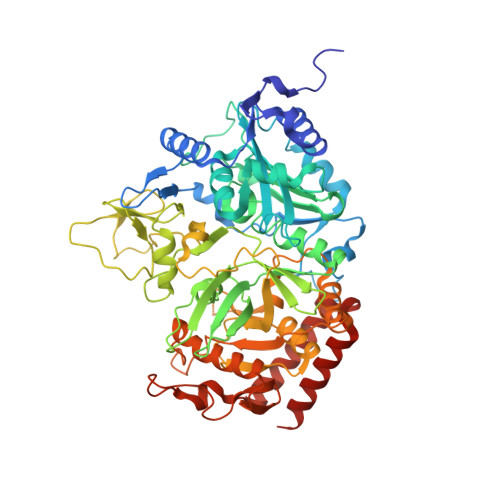Utilization of Substrate Intrinsic Binding Energy for Conformational Change and Catalytic Function in Phosphoenolpyruvate Carboxykinase.
Johnson, T.A., Mcleod, M.J., Holyoak, T.(2016) Biochemistry 55: 575-587
- PubMed: 26709450
- DOI: https://doi.org/10.1021/acs.biochem.5b01215
- Primary Citation of Related Structures:
5FH0, 5FH1, 5FH2, 5FH3, 5FH4, 5FH5 - PubMed Abstract:
Phosphoenolpyruvate carboxykinase (PEPCK) is an essential metabolic enzyme operating in the gluconeogenesis and glyceroneogenesis pathways. Previous work has demonstrated that the enzyme cycles between a catalytically inactive open state and a catalytically active closed state. The transition of the enzyme between these states requires the transition of several active site loops to shift from mobile, disordered structural elements to stable ordered states. The mechanism by which these disorder-order transitions are coupled to the ligation state of the active site however is not fully understood. To further investigate the mechanisms by which the mobility of the active site loops is coupled to enzymatic function and the transitioning of the enzyme between the two conformational states, we have conducted structural and functional studies of point mutants of E89. E89 is a proposed key member of the interaction network of mobile elements as it resides in the R-loop region of the enzyme active site. These new data demonstrate the importance of the R-loop in coordinating interactions between substrates at the OAA/PEP binding site and the mobile R- and Ω-loop domains. In turn, the studies more generally demonstrate the mechanisms by which the intrinsic ligand binding energy can be utilized in catalysis to drive unfavorable conformational changes, changes that are subsequently required for both optimal catalytic activity and fidelity.
Organizational Affiliation:
Department of Biochemistry and Molecular Biology, The University of Kansas Medical Center , Kansas City, Kansas 66160, United States.


















